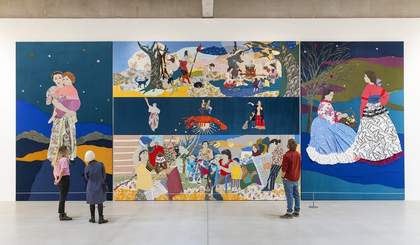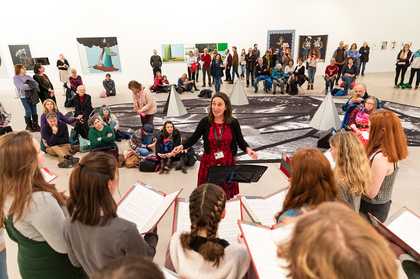Małgorzata Mirga-Tas is a Romani visual artist, educator and activist. Born in 1978, she lives and works in Czarna Góra, a village at the foot of the Tatra Mountains in southern Poland.
Mirga-Tas is known for her textile collages created with materials and fabrics that are mainly gathered from family and friends. Her visual storytelling comes from a feminist perspective and challenges stereotypical representations of Roma people. Often working in collaboration with other women, she sews pieces of clothing, handkerchiefs, tablecloths, curtains and sheets together to create vivid portraits and scenes from everyday life.
She also re-imagines artworks across the centuries that have presented Roma identity in negative ways and transforms them into vibrant images imbued with strength and dignity. In this way, Mirga-Tas reinforces Roma as both a contemporary community and one that has a rich heritage on its own terms.
Mirga-Tas was the official Polish representative at the 59th Venice Biennale in 2022 – the first Roma artist to represent any country.
This will be the artist’s first major museum exhibition in the UK.
Małgorzata Mirga-Tas is organised by Tate St Ives in collaboration with the Whitworth.
INTRODUCTION
‘Mirga-Tas is adept at navigating the irony, incongruity and complexity of Romani life, but also the fertility and pride contained in the concept of being Romani. She gives it form. She embodies it. She thrives.’
– Timea Junghaus
Małgorzata Mirga-Tas is an artist of Romani background based in Poland. She is best known for creating colourful textile collages made with materials gathered from family and friends.
Born in Zakopane, Poland, Mirga-Tas grew up in a Bergitka Roma community in Czarna Góra at the foot of the Tatra Mountains, where she continues to live today. Her visual storytelling is informed by a feminist perspective and a sustained engagement with her community, challenging stereotypical representations of the Roma people. She was the first Romani artist to represent a country at the Venice Biennale, and the first to have works acquired for the Tate collection.
Mirga-Tas brings attention to the everyday life of her community. She depicts family members, collaborators, historical figures, activists and artists, working from current or historic photographs. Often making together with other women, she creates patchworks of materials including clothing, curtains, tablecloths and jewellery, which are sewn together to form what she calls ‘microcarriers of history’.
She reimagines artworks from across the centuries, including some that have presented Roma identity in negative ways, which are transformed into vibrant images of strength and dignity. Mirga-Tas also looks back to specific historical moments, including the Romani Holocaust before and during the Second World War. Combining realism with visual symbols of Romani culture, her works show the Roma on their own terms – both as a contemporary community and as a people with a rich heritage.
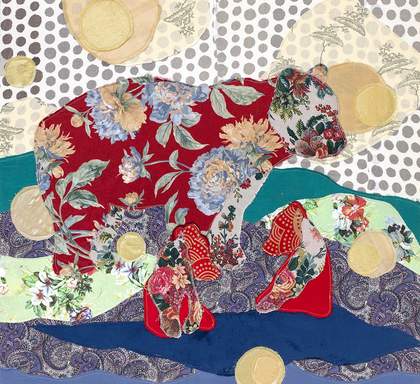
Małgorzata Mirga-Tas, Familia / Family 2022. Courtesy of the artist, Frith Street Gallery, London, Foksal Gallery Foundation, Warsaw and Karma International, Zurich. Photo: Marek Gardulski.
A BRIEF HISTORY OF THE ROMA
The Romani people, or Roma, are a transnational ethnic minority composed of various sub-groups. Despite cultural differences, these diverse Romani communities share similarities including the common use of variants of the Romani language and a unique ethnic origin. Although some groups were historically nomadic, the vast majority of Roma are now settled. Numerous communities have been established in different European countries for centuries.
It was previously thought that the Roma originated in Egypt, and this led to the problematic term ‘Gypsies’, which is often used in a demeaning way. It is now understood that they came from the north of the Indian subcontinent in present-day Rajasthan. The Roma migrated west, moving through the Middle East before arriving in Europe in the 13th or 14th centuries and dispersing across the continent and eventually the world.
Over the course of history, Romani people have been subjected to different forms of discrimination, including deportation, mass incarceration, forced labour, forced sterilisation and assimilation. From the 13th to the 19th century, many Roma lived in slavery in Wallachia and Moldavia (present-day Romania). In the Romani Holocaust before and during the Second World War, Nazi Germany and its collaborators systematically murdered at least 500,000 Romani people, with exact numbers debated. Today, despite a growing international solidarity movement, Roma still experience antigypsyism, a specific form of racism.
ART HISTORY
There are references to historic artworks throughout Mirga-Tas’s practice. She is particularly interested in how the Roma have been shown in art, almost exclusively by non-Romani artists. Key examples are The Gypsies c.1621–31, a series of engravings by Jacques Callot, and similar works by Auguste Raffet from the 1830s. Mirga-Tas explores how the iconography of Roma representation in art history has played a significant role in shaping, spreading and normalising stereotypical and stigmatising ideas about Romani people.
Some of Mirga-Tas’s works are also inspired more generally by European ‘masterpieces’, reflecting a desire to introduce Roma-made representations of Romani culture into the wider history of art. These include Gentile da Fabriano’s Adoration of the Magi 1423 as well as frescoes at the Palazzo Schifanoia in Ferrara, Italy, and various depictions of the daughters of the Ancient Greek god Zeus, known as The Three Graces. By reimagining these acclaimed compositions to show everyday Romani people, Mirga-Tas affords them an elevated status.

Małgorzata Mirga-Tas, Untitled (After Gentile da Fabriano) 2023. © Małgorzata Mirga-Tas. From the Collection of Kiran Nadar Museum of Art, New Delhi, India. Photo: Marek Gardulski.
COMMUNITIES
Mirga-Tas’s work is made primarily with, and about, her own community.
In her studio in Szaflary, southern Poland, Mirga-Tas works with local women – including family members – to laboriously cut and stitch her textile works. The fabrics used in these compositions are often recycled clothes, sometimes even belonging to the people depicted, so that the works further embody their subjects.
The figures are often drawn from photographs either taken by Mirga-Tas, her uncle Andrzej Mirga or other family members and friends. Groups of ordinary Romani people – mostly women – engage in everyday activities including housework, childcare and socialising. Mirga-Tas: ‘By picturing the Roma in this way, showing the normality of their lives, I hope that others can learn to respect them’. Mirga-Tas also celebrates the quiet solidarity that exists between the women around her.
As well as showing her own localised community, her work emphasises the wider community of Romani people across the world, promoting transnational solidarity.
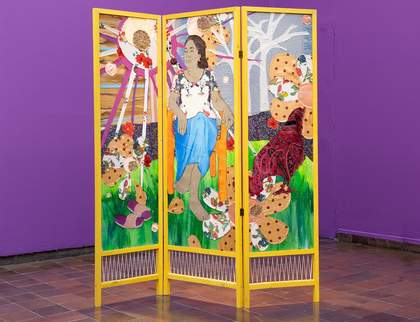
Małgorzata Mirga-Tas, Miri Daj / My Mother 2019. © Małgorzata Mirga-Tas. Courtesy of Tate. Purchased with funds provided by the Central and Eastern Europe Plus Acquisitions Committee 2023. Exhibition view I Have a Dream, Goteborgs Konsthall, 2023. Photo: Hendrik Zeitler.
JOURNEYS
Mirga-Tas examines how her people have been perceived and portrayed over time, particularity in artworks by non-Romani artists, who have historically had a near monopoly over Roma visual representation.
She has looked to engravings by French artists Jacques Callot and Auguste Raffet, whose depictions of Roma in transit contributed to their stigmatised representation in the popular imagination. As Wojciech Szymański writes, ‘Callot depicted caravans of dangerous armed wanderers from the East, wearing spectacular costumes and feathered hats, travelling on horseback and on foot, dragging their belongings in chariots. We observe, too, the stereotypical images of Romani life, in movement and at rest: vagrancy, stealing, fortune telling, bivouacking, meals prepared in cauldrons hung over the fire’.
Many of the works in this space draw on and subvert such images. Mirga-Tas transforms Callot and Raffet’s small scale studies into monumental compositions reminiscent of 17th century tapestries, elevating the status of their subjects, who are reanimated through colour and texture. In this way, historic misrepresentations of the Roma are revised and reclaimed.
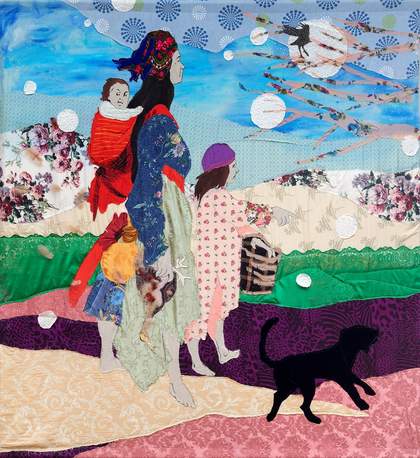
Małgorzata Mirga-Tas, Out of Egypt from the series Out of Egypt 2021. © Małgorzata Mirga-Tas. Courtesy of the artist, Frith Street Gallery, London, Foksal Gallery Foundation, Warsaw and Karma International, Zurich. Photo: Marek Gardulski.
MUSIC AND DANCE
While Roma have mastered many areas of economic and artistic activity, music and dance have in particular been a central part of Romani culture, and this continues today. Romani musical styles vary across communities and countries. In Spain, for example, popular flamenco music and dance is largely the product of local Romani populations.
Many of Mirga-Tas’s works include references to performance. The series The Sacristy of Gitanas Flamencas 2023 uses portraits of Andalusian Romani women to celebrate flamenco culture. These works were produced for the Centro Andaluz de Arte Contemporáneo in Seville, to be shown in architectural frames that previously held 17th century paintings by Spanish artist Francisco de Zurbarán on themes including silence.

Małgorzata Mirga-Tas, Juana Vargas de las Heras, "la Macarrona" 2023. Courtesy the artist and Frith Street Gallery, London, Foksal Gallery Foundation, Warsaw and Karma International, Zurich. Photographer: José Morón.
RE-ENCHANTING THE WORLD
This work is one of twelve large panels that Mirga-Tas created for the Polish Pavilion at the 59th Venice Biennale, where she was the first Romani artist ever selected to represent a country.
Re-enchanting the World is based on a cycle of frescoes painted at the Palazzo Schifanoia in Ferrara, Italy in the 15th century. Known as The Hall of the Months, these monumental wall paintings represent the twelve months of the year and their astrological signs. Mirga-Tas borrowed the compositional structure of these frescoes, as well as specific forms and motifs, to create a wide-ranging survey of the history and contemporary life of the Roma. Referencing Silvia Federici’s 2018 book Re-enchanting the World: Feminism and the Politics of the Commons, the series’s title reflects a desire to recover, or re-enchant, ideas of Romani community, history and identity.
One panel from this series, June, is accompanied here by two works newly made for this exhibition, which critically respond to how Romani women have historically been portrayed in painting and photography.
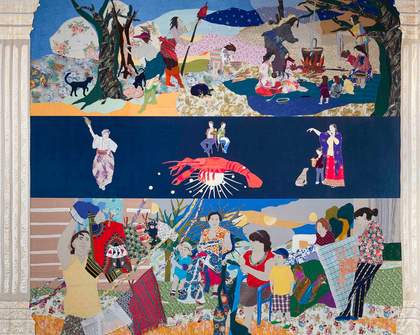
Małgorzata Mirga-Tas, June from the series Re-enchanting the World 2022. © Małgorzata Mirga-Tas. Collection of Museum of Modern Art in Warsaw. Photo: Marek Gardulski.
SIUKAR MANUSIA
These works are from the series Siukar Manusia, a Romani term meaning ‘wonderful people’.
They depict Romani inhabitants of Nowa Huta, an area in Kraków, Poland. Many of them had moved from southern Poland, where Mirga-Tas is based, to work in the factories of this new post-war Communist ‘ideal city’. Personally important to Mirga-Tas, they include activists, community leaders and musicians. Most of them were survivors of the Holocaust, during which hundreds of thousands of Romani people had been killed.
Mirga-Tas based the portraits on photographs shared by friends and family, as well as on various archival sources, including the USC Shoa Foundation and the Fortunoff Video Archive for Holocaust Testimonies. She worked with the subjects or their families to select images and recycled textiles that might best reflect their personalities. Mirga-Tas situates these important figures on dark backgrounds, suggesting that they are emerging from darkness or obscurity to gain the visibility and dignity they deserve.
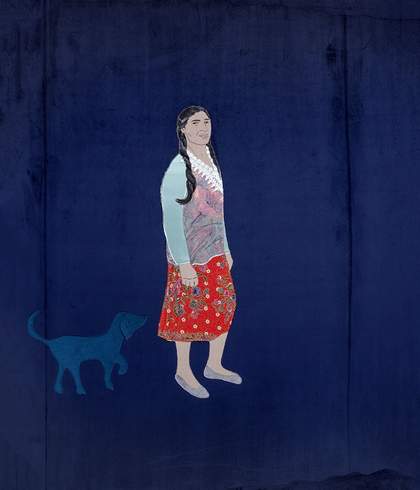
Małgorzata Mirga-Tas, Wanda Siwak from the series Siukar Manusia 2022. © Małgorzata Mirga-Tas. Courtesy of the artist, Frith Street Gallery, London, Foksal Gallery Foundation, Warsaw and Karma International, Zurich. Photo: Marek Gardulski.
Tate St Ives is located on Porthmeor Beach. There is a ramp up to the gallery entrance alongside stairs with a handrail.
There are lifts to all Levels of the gallery, or alternatively you can take the stairs.
- Accessible and standard toilets are on Level 3, next to Gallery 6.
- A Changing Places toilet is on Level 3, next to Gallery 1.
- Ear defenders can be borrowed from the information desk.
To help plan your visit to Tate St Ives, have a look at our visual story. It includes photographs and information of what you can expect from a visit to the gallery.
For more information before your visit:
- Email visiting.stives@tate.org.uk
- Call +44 (0)173 679 6226

